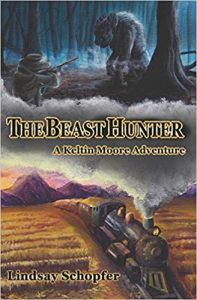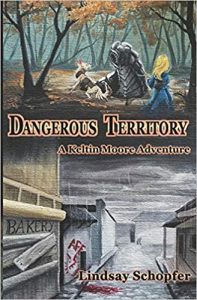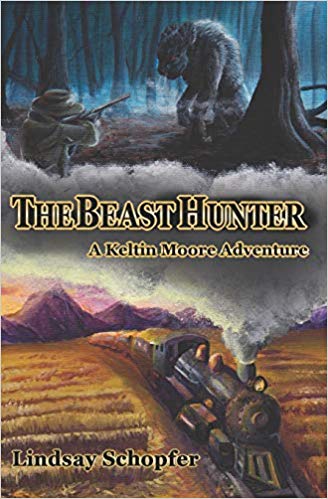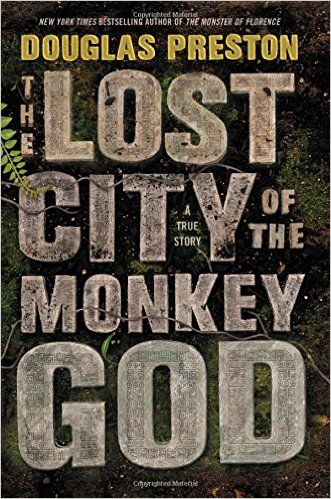 The Hunter's Apprentice: A Keltin Moore Adventure (The Adventures of Keltin Moore #4) by Lindsay Schopfer
The Hunter's Apprentice: A Keltin Moore Adventure (The Adventures of Keltin Moore #4) by Lindsay Schopfer Format: ebook
Source: purchased from Amazon
Formats available: paperback, ebook
Genres: adventure, fantasy, steampunk
Series: Keltin Moore #4
Pages: 275
Published by Lindsay Schopfer on May 25, 2023
Purchasing Info: Author's Website, Amazon, Barnes & Noble, Kobo
Goodreads
Can the beast hunter's apprentice prove his worth?
Professional monster hunter Keltin Moore has worked hard to teach his trade to Jaylocke, his good friend and apprentice. But the time for teaching is over when Jaylocke receives word that the woman of his dreams may marry someone else if he cannot prove to his people that he has mastered his trade.
Together, master and apprentice must assemble their friends and travel the fabled Salt Road to the annual Gathering of the Weycliff wayfarers. But there's more than a simple test of skill awaiting them among the mysterious, nomadic people. Bitter rivalries and titanic beasts will put Keltin's talents as hunter, teacher, and friend to the test as Jaylocke struggles to prepare for the most important trial of his life.
This is the fourth installment of the award-winning Adventures of Keltin Moore, a series of steampunk-flavored fantasy novels. If you love compelling characters, fantastic creatures, and intense action then you will love these stories!
My Review:
 Keltin Moore’s fourth adventure represents a turning point for the famous Beast Hunter AND his family of choice in this fantasy-tinged, steampunk-powered series. When his story began in The Beast Hunter, Moore was very much a lone wolf – in the best Western tradition – relying on himself and his trusty weaponry to make a living out in the wilds, only returning to his rented room in his tiny hometown to rest, refuel, resupply, and of course pick up new jobs so that he can pay for all of the above.
Keltin Moore’s fourth adventure represents a turning point for the famous Beast Hunter AND his family of choice in this fantasy-tinged, steampunk-powered series. When his story began in The Beast Hunter, Moore was very much a lone wolf – in the best Western tradition – relying on himself and his trusty weaponry to make a living out in the wilds, only returning to his rented room in his tiny hometown to rest, refuel, resupply, and of course pick up new jobs so that he can pay for all of the above.
Over the course of Keltin’s subsequent adventures, Into the North and Dangerous Territory, we’ve seen the boundaries of Keltin’s world AND his circle of trusted friends and found family expand to include his business partners and friends, Bor’ve’tai and Jaylocke, his office manager and the love of his life Elaine Desnov (the heroine of The Beast Hunter) and a new business in a bigger town that he hopes will support them all – so that he can finally propose to Elaine.
But Jaylocke isn’t just his friend and his business partner, Jaylocke is also Keltin’s apprentice as a Beast Hunter, and that’s where this story comes in and gives the reader a much deeper dive into the places and peoples that make up Keltin’s not-quite-Weird-West world.
Not all the inhabitants of that world are ‘Original Recipe’ humans. (Which makes a whole lot of assumptions, but I have to start somewhere). Keltin’s partner Bor’ve’tai is a loopi, who look a bit like Sasquatch but are sentient, sapient and have magic. Jaylocke, on the other hand, is a Weycliff wayfarer. His people appear to be a combination of Native American and Romani, but again, I’m using analogies that may not be 100% on any front but helped to get me into the story.
Jaylocke’s people also have magic, but it’s a kind of generational magic that allows adults to tap directly into the knowledge, memories and experiences of their direct ancestors. It’s magic that only comes fully into use when each individual is declared an adult by proving that they have brought a new branch of expertise into their family line. It’s time for Jaylocke to prove that he has become a Beast Hunter in his own right so that he can be declared an adult and marry the girl of his dreams.
The question is whether or not Jaylocke is ready, both to declare himself an adult and a master of his craft – AND to prove it. So, the story of this fourth book in the series, The Hunter’s Apprentice, is all about that apprentice’s quest to stop being one. And it’s about the trials and tribulations he faces as he looks into his own heart to decide whether or not he’s worthy of it after all.
 Escape Rating A: I read the second book in this series, Into the North, first. Between the remoteness of the setting, the whole ‘frozen northlands’ vibe of the thing, and the gold rush in the background of the story, in that book it seemed like the author was channeling Jack London’s Alaskan adventure stories into a place that was not Alaska as it was, or even as London portrayed it was, but somewhere very like it in a world not our own.
Escape Rating A: I read the second book in this series, Into the North, first. Between the remoteness of the setting, the whole ‘frozen northlands’ vibe of the thing, and the gold rush in the background of the story, in that book it seemed like the author was channeling Jack London’s Alaskan adventure stories into a place that was not Alaska as it was, or even as London portrayed it was, but somewhere very like it in a world not our own.
As I’ve continued through the series – which I just devour every time around – it’s not so much that Keltin’s world resembles ours as it was but that it reads like an even further out there Weird West. His world isn’t ours, it isn’t a fantastic version of ours in the way that Weird West stories generally are, but it still has that feel to it.
So if you liked Cherie Priest’s Boneshaker or Laura Anne Gilman’s Huntsmen series (starting with Uncanny Times and continuing with Uncanny Vows later this year), or if the upcoming collection The Good, the Bad, and the Uncanny sounds like it might be your jam, you’ll love Keltin Moore and his fantasy-ish, steampunk-like, world.
This particular story, set in that world, does a bunch of things really, really well for a story that isn’t all that long but does manage to pack a LOT of story into its pages.
First, it’s a road story. Keltin and company take a trip WAY outside Keltin’s comfort zone, giving the reader the opportunity to see more of his world, both geographically and culturally as we get to see Jaylocke’s people at their most removed from so-called civilization and at the peak of their ceremonial celebrations.
 It’s an outsider’s inside view and the reader learns as much as Keltin does.
It’s an outsider’s inside view and the reader learns as much as Keltin does.
It’s also a view of a world that lets nature and the creatures within it be who and what they are in a kind of live and let live symbiosis that is as appealing as it is dangerous – which is how we get caught up in Jaylocke’s quest. As very much does Keltin.
At the same time, it’s a particular part of the hero’s journey, intentionally for Jaylocke but also for Keltin. It’s Jaylocke’s chance to prove he has become an adult, but it’s also Keltin’s chance to learn to let go. Their journey, separately and together is harrowing – as it should be.
The story ends with the hope of a brighter – but different future. One that I hope we get to explore in future books in the series. May they come soon!

 Dangerous Territory: A Keltin Moore Adventure by
Dangerous Territory: A Keltin Moore Adventure by  The Beast Hunter (The Adventures of Keltin Moore, #1) by
The Beast Hunter (The Adventures of Keltin Moore, #1) by  The Lost City of the Monkey God: A True Story by
The Lost City of the Monkey God: A True Story by 